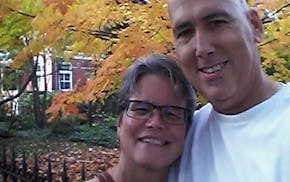The explosions had begun again, rocking the neighborhoods in the warm Minnesota night, from West River Parkway to Sibley Field, from the Chatterbox Pub to the Pink Closet; loud, resonant booms that rattle the windows and set car alarms honking.
For three years, Minneapolis police have been tracking them, with no luck. At first, some suspected anarchists preparing for the Republican National Convention, and the FBI was alerted.
On neighborhood Internet sites, some blame the booms on sewer gas, others on hooligans, the coupling of railroad cars or secret flights from NORAD. The investigations continue, but no one knows for sure what's causing south Minneapolis' Big Boom version of Big Foot.
Last week on several consecutive nights there were reports of loud explosions between 10 p.m. and about 2 a.m. So I called my go-to man on combustibles, William Gurstelle, a self-described "science nerd" who has made a living out of blowing things up in such how-to books as "Backyard Ballistics" and "Absinthe and Flamethrowers." I was looking for answers.
Gurstelle took the challenge. "Let's go find it," he said.
Gurstelle said to pick him up at twenty-four hundred hours at the library. I was pleased Gurstelle was studying our problem, until I realized that The Library is actually a Dinkytown bar. I found him nursing a Pabst Blue Ribbon tall boy. He had an iPad, a digital recorder and a light that he affixed to his forehead.
"Let's do this," he said.
We jumped into the Chrysler convertible and did a full burn toward 46th Street, where an explosion had occurred the previous night.
And we waited.
Gurstelle pulled up his police scanner application on his iPad and the crimes of the city began to crackle: "Officer, report to a rear-end accident ..."
"That's what she said," Gurstelle quipped.
I dug through the bag I'd packed for Operation Boomtown: Bic lighter. Duct tape. Granola bars. My wife had tucked a tin cross into the bag, for safety.
"You think we look suspicious sitting under a street light in the middle of the night with a map, listening to a police scanner?" Gurstelle asked.
"Nah."
I should point out here that no one has been harmed by the explosions. They have caused no damage. They are simply scaring the bejeebers out of the neighborhood.
Also, don't try this at home. We are, after all, professionals.
For two hours or so, we criss-crossed what Gurstelle called "Ground Zero," listening.
"What's that!" Gurstelle said at one point.
Long pause. "An airplane."
About 11:30 we heard a scream from a stand of trees. Four kids on bikes and skateboards roared by. "Ello!" one said in an English accent.
"Suspicious," I said.
"Anybody in a park at this hour is suspicious," Gurstelle said.
We stationed near the dam and Gurstelle worked his science to try to eliminate the potential causes. The city would likely be able to tell if it was sewer gas, he said. "Not probable."
NORAD denied being in the area, so that was out, if you believe military agencies. Sonic booms were "completely implausible" because the whole city would hear them, he reasoned.
Anarchists? "No," said Gurstelle. "Anarchists aren't that bright, they'd leave evidence."
Gurstelle said many cities claim mysterious sounds, like the "Taos Hum," and "The Bloop," a blooping noise heard under water.
Then Gurstelle sketched on my notebook the most plausible solution I've heard so far. It's something he's done many times, using easily attainable products, and water. (In the interest of public safety, we'll skip the details).
"It's really, really loud," he said. And when it blows, it leaves almost no trace.
"That's it," I said. "It would explain bits of shredded plastic at one scene."
But what would motivate someone to do that many times during a summer, for three years?
"There is no motivation for a [name deleted] bomb," he said. "It's just fun."
We drove some more. I was tired.
"Let's be skeptical," said Gurstelle. "The neighborhood has an assumption that these booms are related."
By now, however, scientist Gurstelle had convinced himself they are not. One is a firework, another a car backfiring, another a train coupling. But people love to be part of the mystery, and so they link the booms, he said. We are bad in identifying and describing sounds, but excellent in seeing patterns that don't exist.
"We are a pattern-seeking machines," said Gurstelle. "I think everyone is hearing something different. How do we make that story sexy?"
Some time around zero thirty hours, we called off Operation Boomtown. The night was quiet. The mystery lives.
jtevlin@startribune.com • 612-673-1702

Tevlin: 'Against all odds, I survived a career in journalism'

Tevlin: Grateful Frogtown couple fight their way back from fire and illness




